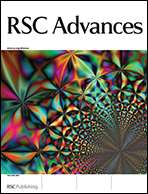Ionic liquid microemulsions of 1-butyl-3-methylimidazolium hexafluorophosphate, N,N-dimethylformamide, and water†
Abstract
The phase behavior of a ternary system consisting of the hydrophobic ionic liquid (IL) 1-butyl-3-methylimidazolium hexafluorophosphate (bmimPF6), N,N-dimethylformamide, and water was investigated. Single-phase microemulsion and multiphase regions were observed in the ternary phase diagram. To the best of our knowledge, this is the first report of aqueous IL microemulsions prepared in the absence of traditional surfactants, i.e., surfactant-free microemulsions (SFMEs) containing IL. The microstructures and structural transitions of the aqueous IL SFMEs were investigated using cyclic voltammetry, electrical conductivity, and dynamic laser light scattering techniques. The results showed that the aqueous IL SFMEs exhibit IL-in-water, bicontinuous, and water-in-IL microstructures, similar to the case of traditional surfactant-based microemulsions. The three kinds of microstructures were confirmed from freeze-fracture electron microscopy observations. Ultraviolet-visible and fluorescence spectroscopies were used to examine the polarities of microdomains in the microemulsions, using methyl orange and pyrene, respectively, as probes. It was found that these two techniques can be used to identify the microstructures and microstructural transitions of the aqueous IL microemulsions.


 Please wait while we load your content...
Please wait while we load your content...